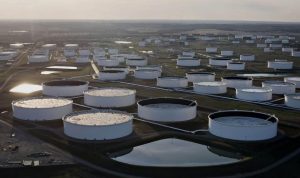
The Cushing terminal is still growing. More and more tanks are being constructed to store crude oil coming from the rest of the nation.
As Jack Money, Business Writer for The Oklahoman reported this week, analysts now believe midstream companies will have the ability by the end of next year to transport more oil out of the Cushing hub than is being shipped there.
Read the entirety of his story below:
Analysts that closely track oil inventories at the Cushing terminal predict midstream companies by the end of next year will have the ability to move more oil out of the terminal than can be brought in.
Still, much of the information provided by a Genscape webinar last week illustrates that the terminal, a collection of companies that store and ship crude and condensates, continues to play an important role in storing and distributing oil and other liquids to downstream users.
The briefing was conducted by Genscape’s Hillary Stevenson, director of oil markets and business development, and Ryan Saxton, its director of midstream oil.
Together, they discussed the terminal’s recent rapid growth in storage capacity and connectivity to both upstream fields and downstream export facilities, refineries and other end-stream users of what it stores.
Stevenson and Saxton used data Genscape collects to outline the terminal’s current operations.
The company monitors 100% of the Cushing terminal’s inventory by overflying the facility twice weekly and documenting tank levels using both traditional and infrared cameras.
It monitors pumping station power consumption rates on 94% of the lines connected to the terminal using a patented remote sensing device.
It also uses fixed visual cameras to monitor railcar deliveries of oil to a Cushing operator’s rail crude delivery terminal in Stroud, and uses fixed infrared cameras to monitor the operations of connected downstream refineries.
During the past 10 years, they said, Cushing’s operational capacity has nearly doubled, from about 55 million barrels in 2009 to about 99 million barrels, which is how much combined operators would be capable of storing once construction ends on a group of tanks now under construction.
The terminal’s connectivity to both upstream suppliers and downstream users also has greatly expanded.
In 2012, the terminal only had one pipeline coming to it that was capable of moving more than 500,000 barrels a day. None of that size was leaving the facility. Daily flows in averaged about 1.75 million barrels daily, while daily flows out averaged about 1 million barrels daily.
In May, the terminal had three pipelines with capacities of at least 500,000 barrels of oil daily bringing product in, with two others that size capable of moving oil to the Gulf Coast. Daily flows to the terminal averaged about 3 million barrels a day, while daily flows out averaged about 2 million barrels a day.
“Today’s map looks like a web,” Stevenson remarked.
As for pipelines, Saxton said work is underway on eight different lines that will connect to Cushing.
Only one, however, the Phillips 66/Bridger line with a capacity of 350,000 barrels per day from the Bakken and Niobrara shale plays, will carry oil to Cushing. The remaining lines, ranging in capacity from 85,000 to 800,000 barrels of oil per day, are expected to carry oil from Cushing to the Gulf Coast.
However, Magellan Midstream Partners, Plains All American Pipeline and Western Midstream Partners announced Thursday they plan to boost the capacity of their Saddlehorn Pipeline, which carries oil to Cushing from the Denver-Julesburg and Powder River Basins to 290,000 barrels per day, an increase of 100,000 barrels.
That should help even out the flows, at least somewhat.
“One of the most interesting dynamics that will develop over time really is the potential to not only shift additional barrels out of Cushing, but also the ability to divert inbound barrels away from Cushing altogether,” Saxton said.
Stevenson and Saxton also discussed how Cushing inventories have fluctuated the past couple of years because of refinery maintenance, pipeline leaks and market conditions.
The terminal held less than 30 million barrels of product in September, but held more than 50 million barrels in June and part of July.
Meanwhile, the expansion of Cushing’s terminal has been dramatic. In 2009, it had 200 tanks. Now, it has 415, with 15 more being built.
“It certainly has not slowed down in growth,” Stevenson said.
Cushing’s future
The growth of the Cushing terminal and changes in its ability to move product might raise questions about whether it will lose importance to traders who, through buys and sales, move the price of West Texas Intermediate up and down.
However, Robert Dauffenbach, director of the Center for Economic and Management Research at the University of Oklahoma’s Price College of Business, said the terminal has held 15% or less of stored U.S. oil during the past 15 years.
Research Dauffenbach conducted showed, in fact, that Cushing appears to be a popular place to stash oil when prices are poor, as that is historically when its inventories have substantially climbed.
Its inventory of stored products falls typically falls when prices are better, it shows.
Dauffenbach observed pipelines getting built in Texas, capable of moving 2.5 million barrels per day, aim to get product from the Permian Basin to the Gulf Coast, and agreed that could cause the overall percentage of crude produced in the U.S. that flows through Cushing to fall.
“Exports have been increasing, and these new facilities will be ever more supportive of increased export capacity,” he said.
However, he said he expects that flows of oil coming to Cushing from Canada, the Bakken and Niobrara shale fields will remain strong, especially once the Keystone XL line is built.
Complex refineries in the U.S., Dauffenbach and the Genscape analysts said, rely on heavy oil to help them make gasoline and diesel.
“Heavier Canadian crude would be a plus for Cushing, I think,” Dauffenbach said. “It will still be a major player.”





